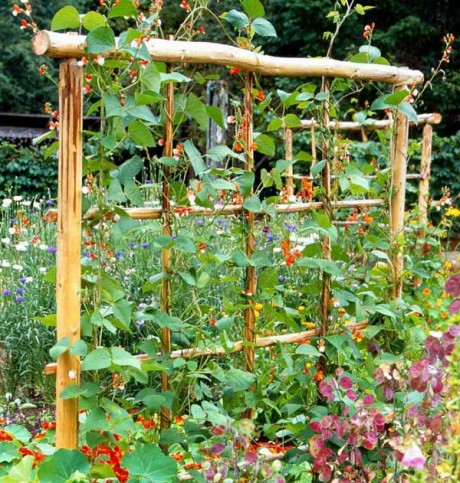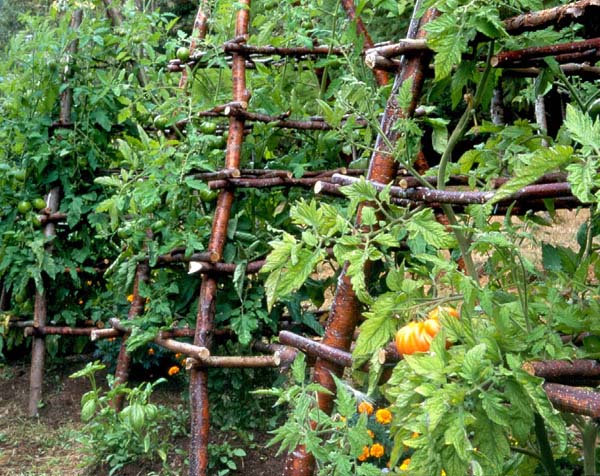Using trellises
Decorative and functional
By Kris WetherbeeThere are many different kinds of trellis systems to choose from for your garden. Here's an overview of some of the most useful setups.
Cages: Often used for tomatoes, cages can also support prolific peppers and eggplant. Reinforce cone-shaped cages by sinking two to three stakes on the inside of the cage.
Metal stakes and spiral rods: Plants are wound around and loosely tied up a single 6- to 8-foot tall stake or rod. Fruit is easily accessible, but the plant must be pruned to one main stem for optimum effectiveness. Best suited for growing tomatoes.
Teepees: 8- to 10-foot poles made of bamboo, wood or metal are used to make this teepee-style trellis. The frame is wrapped in string, chicken wire or netting for vines to climb. Ideal for pole beans, pole peas and cucumbers.
Organic trellis: Corn stalks can be used as support posts for growing beans. (Sow corn three to four weeks before sowing beans.) Wood branches with twiggy growth and a stem at least 2 inches in diameter (sink the stem into the soil at least 1 foot deep) create an organic structure for supporting vigorous bush peas and beans.
A-frame trellis: Two heavy-duty wire panels or wooden frames covered with wire or plastic mesh are leaned together to form an A-frame and then secured at top with wire or hinges. Seeds are then sown along both sides at the bottom of each frame. Best for beans, peas and most edible vining and non-bush crop varieties with small fruits.
Row trellis: For the "Frame and Wire" method, a wood, metal or PVC pipe frame with extended legs is sunk 1 to 2 feet into the ground. Wire or twine is then tied to the upper and lower sections of the horizontal frame. The "Stake and Weave" method consists of 6- to 10-foot steel T-posts spaced 4 to 6 feet apart. Heavy-duty string, twine or wire is stretched horizontally between posts and then attached to each post. For tomatoes, weave a new line around plants as they grow in height. Attach trellis netting to the posts with staples or tie with wire or twine for growing cucumbers, pole beans or peas.
Supporting fruits and vegetables
Basically, any vining or sprawling plant with fruits smaller than a bowling ball can be trellised as long as there is a sturdy, tall structure strong enough to support the weight of the mature plant and its fruits.
Lightweight trellis structures are often adequate to support the weight of cucumbers, pole beans and peas. Those needing sturdier support include indeterminate tomatoes, non-bush varieties of summer squash and small-fruited winter squash.
A heavy-duty trellis is required to support grapevines and non-bush varieties of small melons or pumpkins (bowling ball size or smaller) and winter squash. You can further support developing melons, pumpkins and squash with a sling made of nylon stockings or other stretchy material attached to the trellis.
About the Author
Oregon-based writer Kris Wetherbee specializes in the areas of gardening, food and outdoor living.-
Share this story:
{ampz:Custom share for module}

